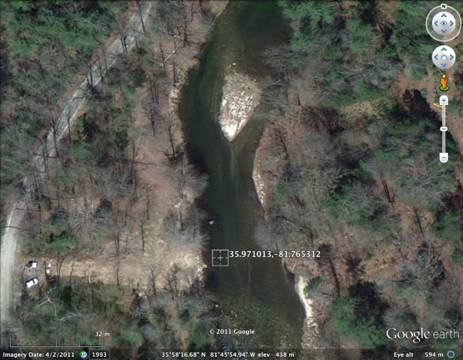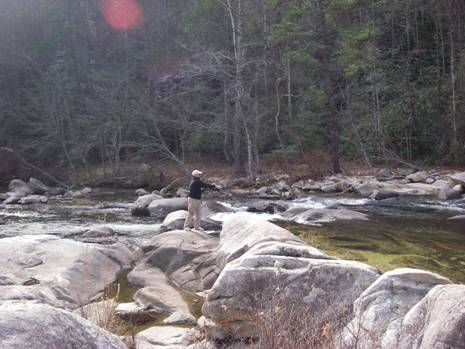GASP REFLEX FLY FISHING
I retired in January of this year and with my newly available spare time I have taken up fly-fishing after years of sporadic efforts to learn the sport. My father initially taught me how to cast in the mid-1970's and other than a few opportunities to catch bass in Alabama and a few Rainbow trout in the Arizona high-country I haven't had much experience fly-fishing. So this year I have spent time trout fishing with both of our sons, my oldest brother and my son-in-law across the country. As you can imagine, I have a very understanding wife (of almost 40 years now).
It has been a great time for all of us and because each of them has had the good fortune to live in some spectacular areas I have had the pleasure of fishing this year in the Farmington River in Connecticut (where our oldest son Dave lives), in the Letort and Yellow Breeches in Pennsylvania (where my brother Tom lives just 15 minutes from both of them), the South Platte and Big Thompson Rivers in Colorado (where our son Jon lives), and finally, Wilson Creek in western North Carolina which is near Charlotte (where our daughter Kris and her husband Aaron and granddaughter Emily live). Since I live in western Michigan I have had the opportunity to fish for trout in the Au Sable and Muskegon Rivers along with some other nearby trout streams. Life is good.
So, on Saturday, November 26, 2011 I took my son-in-law Aaron fly-fishing on Wilson Creek for the first time. I taught him and he quickly learned basic casting techniques after a couple of hours on the water and really enjoyed himself.
Beautiful Wilson Creek's headwaters are in the Grandfather Mountain north of Mortimer, NC and by the time the water reaches the Delayed Harvest section we were fishing it is very clear and cold. In fact, I don't recall ever seeing water that clear, including the shallows near the Florida Keys. I didn't measure the water temperature but it was cold – after two hours my toes were really cold (I was wearing fleece pants under my waders and boots).
I was also wearing a Level 1 undergarment with a wool shirt and a fleece jacket under my vest. The air temperature was around 50 degrees as it approached noon with a light overcast sky but I was warm enough everywhere but my feet.
I had worked myself around the bottom of the pool and along the shallows on the east side of the creek, sight casting to fish in the middle just below the island. The depth appeared to be about a foot deep. There were fish holding in various spots and they were easily seen and did not spook. They were rising to a small hatch and I missed four of them.
Below is an aerial photo of the pool we were fishing in. Just above the lat/lon marker in the photo is a boulder on the west side of the creek. I had decided to wade across the creek below the boulder due to the clarity of the water and my assumption that it wasn't very deep. In fact, since the creek appeared so shallow I had not bothered to bring my wading staff with me – after explaining how useful it was to Aaron I left it in the Jeep when we first arrived.

Below is a picture of Aaron casting in the lower gorge section of the creek taken later that gives some idea of the water clarity:

I started wading across the creek and as I passed through the middle of the creek the depth rose rapidly to about 6 inches above my wading belt. I was very surprised but by that time I was below the boulder, could see the bottom clearly and my thought was that it shouldn't get any deeper since I could see the bottom. The current was light and I wasn't in danger of being pushed off my feet. I figured that my next step would have to take me up the other side of the cut and I could climb out on the bank.
I was wrong.
My next step put me in water that was over my head deep. I caught myself just in time to prevent my head from going under water but my instant response was to gasp with the cold water hitting my chest. I managed to swim and lunge on over to the bank with my upper body clothing totally water logged. I quickly got on shore and stripped the gear off and got to the Jeep about a hundred yards away and got dried off. I had a little water in my waders but my tight belt helped keep it to a minimum. Thankfully I had a change of clothes in the Jeep.
I had carried my keys and my iPhone with me in the wader chest pocket but hadn't bothered to use a Ziplock bag since I had never fallen in the water before and loved to take pictures as I fished – and this water looked so shallow. The keys and phone were soaked but the keys still worked. The iPhone was dead and I am in the process of replacing it now.
Before I left on this trip I was doing some Internet research on Wilson Creek and came across a tragic story of a fly fisherman who had drowned there in 2010. He apparently slipped and did not recover. The account had some comments by other fisherman who supported keeping a tight belt and some who said the opposite was the better way. The website is worth a quick read, it is short and poignant:
https://www.tarheelflyfishing.com/2010/04/tragic-day-on-wilson-creek.html
When I told my brother Tom about this (he has been fly fishing for 50 years now) he first told me he was glad he got the email – meaning that he heard about it from me rather than someone else reporting a statistic. He then explained the phenomenon of the "cold water gasp reflex" which apparently is a cause of quick death in cold water and can occur very quickly and prior to death by hypothermia. I had apparently gotten close to that but my head did not go under water, which prevented my intake of water with the involuntary physiological gasp reflex. An Internet search on this subject sheds light on this reflex and it appears most of the information revolves around kayaking in cold water environments.
I did a search on the FAOL site to see if I could find anything related to it but I was unable to find anything – perhaps others in FAOL are aware of it.
I did learn a few things from this. First, the wading staff - always, always take the staff! I should have known better.
Second, the fleece jacket would have been better replaced by my wading jacket, which would have protected my chest – I would not have been so soaked with that approach.
Third – the electronics. Oh, this is embarrassing. I am an electrical engineer, having spent a career dealing with electronics in various industries. Ziplock bags…
And finally, cold water survival techniques; in my zeal to fish I did not pay enough attention to the environment I was in. Another admission here – many years ago I was a Navy diver on a nuclear submarine. I went to the USN dive school in Key West in October of 1970 and made many dives on our submarine as she was tied up beside the sub tender during month long refits in Rota, Spain. The coldest dive I made was just prior to getting underway on a Polaris patrol on Christmas Eve of 1972. I was wearing a ¼ inch wet suit and diving in water that was 54 degrees. I came up after about half an hour and was beginning to turn blue – one of the early signs of hypothermia. It doesn't take long to get very dangerous in cold water even if you're prepared.
So, as I finish off the first year of retirement and my headlong pursuit of fly-fishing, I have to thank God I survived it. I have most certainly enjoyed it!
I hope all of you out there in the FAOL community enjoy the sport safely.
